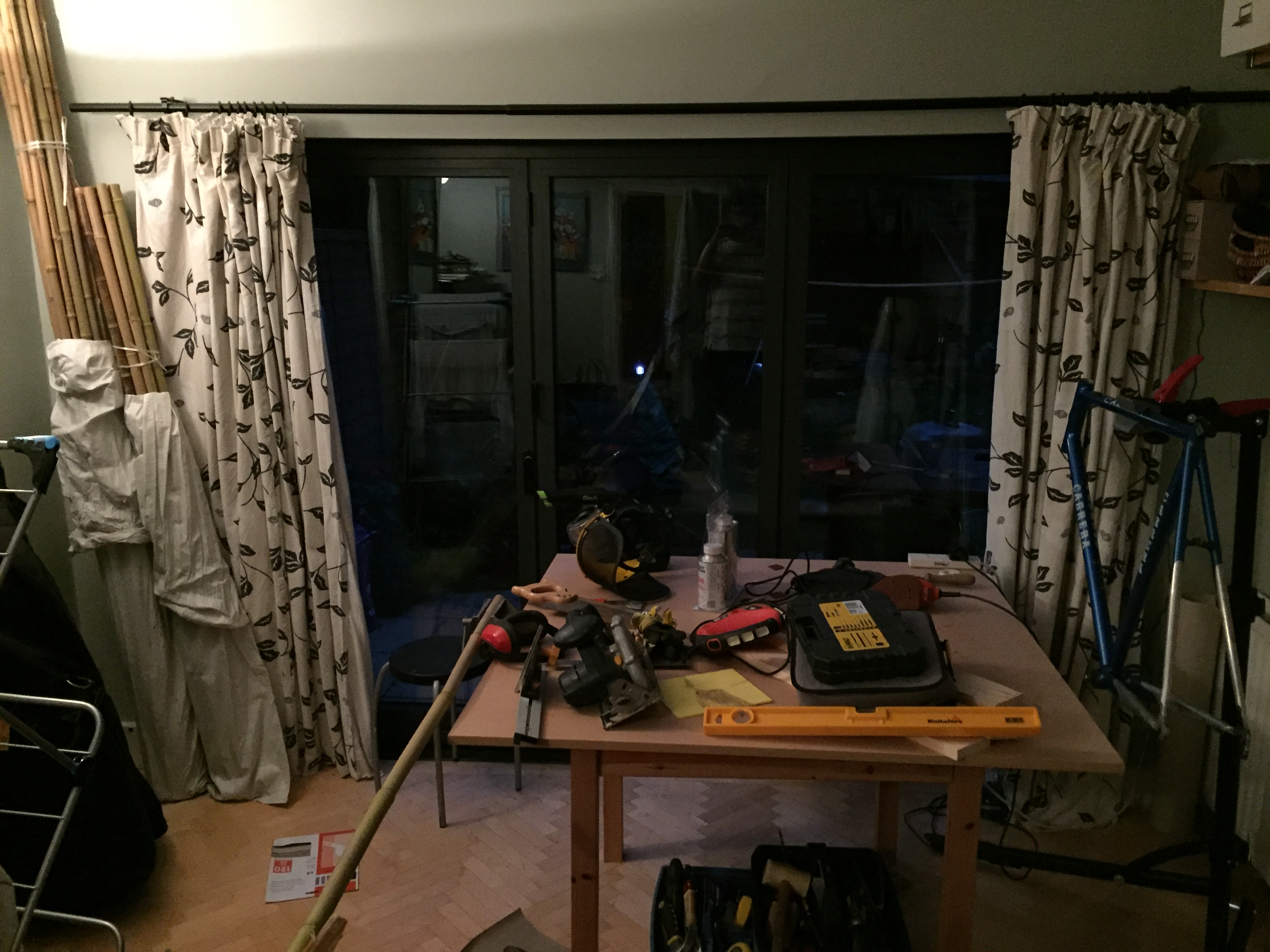2020 - My Bamboo Bike

Inspiration
On a tired Tuesday morning, I sat in a materials lecture attempting to absorb the copious information being sent my way like a sponge. But halfway into the lecture one thing really caught my eye: a CES graph of all things.
I had been listening to a discussion about a flimsy aluminium bike on the stage - a hunk of metal clearly not safe for the road - and it had got my mind racing. The latest and greatest bikes were all made of CFRP, but I was a student so CFRP might aswell be gold. My eyes went wondering along the performance index line we had learnt to draw. Away from Aluminium and CFRP was an inconspicuous bubble, never pursued in the lecture.
I went home and downloaded the CES software to find out what that green bubble might be hiding. To my surprise it was bamboo.
 Figure 1: Young’s modulus vs. density with performance index for stiffness-limited design
Figure 1: Young’s modulus vs. density with performance index for stiffness-limited design
Design
During research, I found a research paper written by Blair Frandeen from Single Track Vehicle Design Cal Poly, San Luis Obispo and Professor John Fabijanic [1]. Full credit is given to this team for any design and/or inspiration taken from this document. Figure 2 shows these drawings. They were altered slightly to accommodate a slightly larger frame size due to my height of 6’3.
In reality, there are very few precise measurements that have been taken on the material properties of bamboo, specifically on the different species of bamboo found across the world. One study commissioned by The Bamboo Bicycle Club completed by Portsmouth University, UK compared two widely used strains of bamboo for these sorts of applications: Tonkin and Moso [2]. This study revealed that Tonkin cane bamboo had an astonishing ultimate tensile strength of 240 MPa, surpassing many metals. From this study and other online sources [3], I decided to use Tonkin cane bamboo.
Due to historical specifications, I decided it was simply too difficult to manufacture the head tube, bottom bracket shell and rear dropouts from bamboo. Furthermore the wheels, stem, handlebars and groupset were also salvaged from old bikes. See figures below.
To form the joints between the bamboo canes, I required an adhesive that bonded well with both metal and bamboo whilst also being suitably strong to take the forces required of a bike whilst riding. For this reason, I selected an epoxy resin otherwise used for wooden boats, combined with hemp fibre which is a sustainable material widely available and commonly used by plumbers [4].
 Figure 2: Drawings from which the bike was made
Figure 2: Drawings from which the bike was made
Manufacturing
Figure 3 shows my initial setup, on top of which I stuck the full detailed frame details I printed off to scale to work from. On the left of the picture, the bamboo canes I imported are shown [5].
I began by sawing off some salvegable parts from a couple old bike frames I had found online as shown in Figure 9 and 10. Unfortunately the Italian frame I found had an old bottom bracket shell with Italian specifications, and I knew this would make finding a suitable bottom bracket and other parts down the road difficult (it was also impossible to wrench off the old BB!). Soaking the hemp fibre in the epoxy resin, I began to put the various parts together. Using some old cardboard and aluminium foil I ensured each fibre was suitably soaked, but I was limited in the volume of epoxy available to me.
I would saw the bamboo to the right length and then print off a tube-mitre sheet to wrap and sand the bamboo down to slot in together [6]. I tried to saw the metal parts enabling the suitably selected bamboo (I had bamboo of all sizes between 10-30mm ) to be slotted inside. This allowed for a much easier process of fixing the pieces together and a stronger final build. This allowed me to initially pour a little epoxy into the joint before securing later by wrapping with the hemp fibre. However, this was not always possible. Ultimately the joints which were purely fabricated by sanding down bamboo to fit together were the weakest parts of the bike.

 Figure 4: Italian frame from 1980s
Figure 4: Italian frame from 1980s
 Figure 5: Newer English frame
Figure 5: Newer English frame
Assembly
Once the frame had been assembled as shown in Figure 6, it was time to add all the other parts a bike requires to roll along the floor: handlebars, a fork, wheels, a seat and a groupset.
Since I was on a tight budget, almost everything was purchased used and finding suitable used parts was not easy: it mainly involved cycling on my main bike across London to meet with Facebook Marketplace and eBay sellers. Since the frame had been self-fabricated, it was also difficult to find metal parts of exactly the right specification for my creation. The solution to this was inevitably just to adjust, saw and grind as I went along. One such example was the seat post, since the bamboo that was left to attach to a seat was far smaller than a typical seat-post. This was solved by buying a suitably cheap seat clamp that allowed me to bend it to about half its previous size.
I opted to buy a single speed groupset to simplify the assembly. The bike has a fixie cassette on one side with a freewhell and a single speed cassette on the other. This meant no gear levers and cables to a rear derailleur were required.
 Figure 6: Completed bamboo frame
Figure 6: Completed bamboo frame
Completion and issues
The bamboo bike was completed about 3 months after initial research was first performed, although many long breaks were taken. An estimate of around 100 hours were spent working on it.
Some epoxy had evidently seeped into the bottom bracket shell, since the bottom bracket refused to thread in correctly. I attempted to clean it out, but the bracket simply would not go all the way in. Furthermore, there was a slight twist in the back of the frame, leading to a some-what non-straight placement of the back wheel. This initally rubbed against the bamboo, but the creation of a custom washer with a small piece of bamboo solved the issue. Finally, my make-shift solution to sit a seat on-top of the bike is not the most secure. I should have perhaps used a larger diameter bamboo cane for the seat tube to fit a stronger and more standard seatpost to. Finally, I was unable to seamlessly install the headset, simply due to my lack of expertise with bikes. It functions correctly, but with some alternations could be more smooth.
The following figures provide some more photos of the final bike.
 Figure 7: Front view
Figure 7: Front view
 Figure 8: Rear view
Figure 8: Rear view
 Figure 9: Groupset
Figure 9: Groupset
 Figure 10: Seat
Figure 10: Seat
Failure
The bike was extremely comfortable to ride and certainly fast. It is very light at only 9.1kg. However, as expected, the bamboo was very susceptible to splitting, especially on going over road obstacles such as pot-holes. Mr Frandeen explores this further in his paper.
Whilst riding, one of the rear seatstays split and unsurprisingly it slid out of its joint with the seat post as detailed by Figure 11. At no point did the bamboo snap, giving insight into its extraordinary strengths. Although this particular bamboo member would now need to be replaced due to the splitting, the bike was easily fixed and remains cyclable. More hemp and epoxy would need to be applied to further strengthen the frame, perhaps even repairing the split bamboo member. I opted not to do this as a memento of the moment it broke beneath me.
 Figure 11: Rear seatstay sliding out of its socket
Figure 11: Rear seatstay sliding out of its socket
| What | Price | Shipping | Total |
|---|---|---|---|
| Bamboo | £90.60 | £15.00 | £105.60 |
| Hemp fiber | £18.72 | £5.10 | £23.82 |
| Epoxy resin | £41.99 | £41.99 | |
| Bike to take apart x2 | £33.00 | £8.20 | £41.20 |
| Bike workstand | £79.99 | £79.99 | |
| Electrical Tape | £0.89 | £0.89 | |
| Clamps | £6.00 | £6.00 | |
| Digital Vernier Calipers | £5.29 | £5.29 | |
| Misc. tools | £28.49 | £28.49 | |
| 4x4 MDF Board | £16.29 | £16.29 | |
| Seat | £9.99 | £4.10 | £14.09 |
| Chain, break and cable | £26.98 | £26.98 | |
| Tyres | £26.00 | £26.00 | |
| Stem & headset | £26.40 | £26.40 | |
| Groupset and wheels | £80.00 | £80.00 | |
| Total: | £523.03 |
Table 1: Cost breakup of complete project
Cost
The costs detailed in Table 1 are amount to an approximate 60% overspend. This is made up of being unable to buy a small number of canes of bamboo in one shipment and also include more tools than initially anticipated. One of the students who I picked up a metal frame from told me that I would spend 50% more than I planned. He was right.
I am very appreciative to the Lumely Curriculum Encirchment fund for its support of this project.
UPDATE: June 2022
I was grateful in 2022 to receive a further grant from the Cambridge University Engineering Society (CUES) to fix some of the issues described above, and for further protection of the bamboo frame. My report is given below:
I dedicated a huge amount of time over the COVID lockdowns to building a full bamboo bicycle. It was a hugely rewarding project that was a much-needed escape.
But as things have eased, I never found the time or funds complete the final bits of the project. This included securing the joints, finishing/cleaning the final frame and building a wall stand. With the generous support of a CUES grant, I recently completed these and the bike is now both ride-able and rather aesthetic! This both enabled me to apply academic skills and learn about a long-scale project.
Over a few days of glorious weather after exams, I returned home and worked in the garden on the bike. I began by deconstructing it and cleaning/sanding it thoroughly. I then secured the joints further by wrapping more hemp fibre soaked in Epoxy resin. Sanding these joints and the bamboo down after produced a lovely result. Some of the tools purchased using this grant were what enabled this work and these were tools I was previously unaware of!
I finished by building a pretty wall mountable stand for the bike, ready to display it for a long time.
Thank you very much for the support of this grant and other supporters of this project.
| What | Price |
|---|---|
| West system Epoxy Junior Pack | £24.25 |
| Heavy duty rubber gloves | £3.49 |
| Brush pack | £2.79 |
| Dremel | £44.18 |
| Electrical tape | £2.00 |
| Tungsten Carbide bits + sanding bands | £29.26 |
| Wall mount straight arm | £24.68 |
| Total | £130.65 |
Table 2: Cost breakup of additional work on project
References
[1] Blair Frandeen and Prof. John Fabijanic, The Design and Fabrication of a Bamboo Bicycle
https://tudelft.openresearch.net/image/2015/10/27/bambuscykel.pdf
[2] Portsmouth University Study on Bamboo Species, Bamboo Bicycle Club London
https://www.bamboobicycleclub.org/en/portsmouth-university-study-bamboo-species/
[3] Flora Bamboo
http://www.florabamboo.com/index.php?m=Article&a=show&id=
[4] Building A Bamboo Bike
https://bamboobike.wordpress.com/42-2/
[5] BS Bamboo
https://www.bs-bamboo.co.uk/product-page/6ft-1-82m-30-35mm-diameter-
natural-tonkin-bamboo-canes-10-cane-pack
[6] Tabbed TubeNotcher Pattern Creation Tool
https://dogfeatherdesign.com/ttnjs/
Gratefully supported by both:
- Lumely Curriculum Enrichment Fund
- Cambridge University Engineering Society
